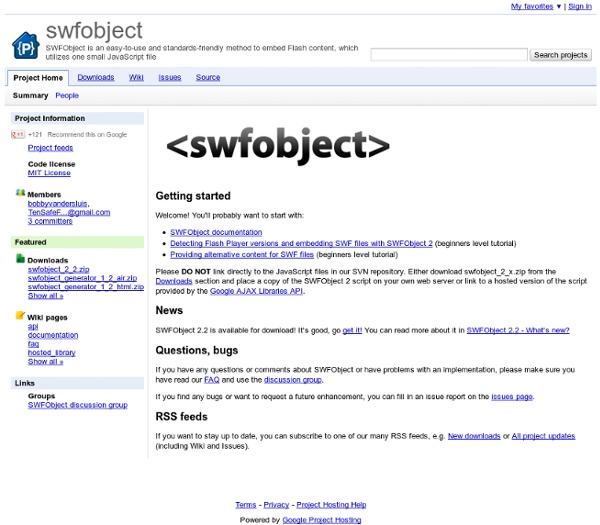



Comment détecter des appareils mobiles avec du javascript - PL en toute liberté Vous voulez que les visiteurs équipés d'un appareil mobile (iPhone, Ipod, Android, etc) puissent choisir la version mobile ou standard de votre site Web? Voici une petite astuce. Insérer ce code dans la page d'accueil de votre site (entre les deux balises HEAD): Pour voir ce que ça donne avec votre mobile, voir ce site. Pour voir le rendu dans votre navigateur, cliquez ici. Si vous utilisez SPIP somme gestionnaire de contenu, le plugin iSPIP facilite la création du site pour mobile. Mise à jour: J'utilise ce script afin d'ajouter un gros bouton rouge dans la page d'accueil qui donne le choix au visiteur de naviguer dans le site normal ou version mobile.
Introduction to RDFa II In part I of this series, we looked at how semantic features normally confined to the head of an HTML document can be used to add semantic richness to the elements of the body. Along the way, we defined six rules of RDFa: The link and a elements imply that there is a relationship between the current document and some other document; the @rel attribute allows us to provide a value that will better describe that relationship.The @rel and @href attributes are no longer confined to the a and link elements, but can also be used on img to indicate a relationship between the image and some other item.In ordinary HTML, properties are set in the head of the document, using @content with meta. In part II, we’ll learn how to add properties to an image, and how to add metadata to any item—and we’ll add a few more rules to that list. Adding properties to an image#section1 For example, to indicate when an image was created, we might do this: (Line wraps marked » —Ed.) Rule 7:#section2 Rule 8:#section4
Scriptalizer.com: Combine and Minify Your Javascript and CSS! Media Queries JavaScript Madness: Keyboard Events Javascript Madness Intro Jan Wolter 1. Introduction This document summarizes the results of some browser tests done while attempting to implement key stroke handling code in JavaScript. It documents inconsistancies in the way different browsers implement keyboard events. The tests were originally done with the intention of learning just enough to write the code I needed to write. This data is based on tests of many, many browsers over many, many years, but is not comprehensive. The script used to collect the test results reported here is available at This document will usually refer to "Gecko" instead of "Firefox" and to "WebKit" instead of "Safari" or "Chrome". Previous versions of this document included coverage of the iCab 3 browser, but iCab has switched to using the WebKit rendering engine, and so presumably behaves exactly like Safari. 2. The keydown event occurs when the key is pressed, followed immediately by the keypress event. 2.1. 2.2. 2.3.
55 Best jQuery Carousel Plugins In web design, a jQuery carousel is an element giving visitors easy and visible access to several content items. It is typically a dynamic scrolling list of items in horizontal order where previous and next items are partially visible. The items, consisting of HTML content, images, videos etc. can be scrolled back and forth (with or without animated transitions). Using sliding horizontal panels, known, as Carousels and Sliders, to feature top content, is one of the strongest web design trends over the last couple of years. It is a very effective method to increase the web site usability and engage the user. The reason for this trend is mainly the arrival of jQuery that have made it almost a “walk in the park” to add a jQuery carousel or a jQuery image slider plugin to a web site. Disclosure: Please note that some of the links below are affiliate links and I will earn a commission if you purchase through those links (at no extra cost to you). Advertisement JCoverflip – MORE INFO / DEMO
Free software downloads, audio tools, internet utilities, Direct jQuery.dotdotdot, advanced cross-browser ellipsis for multiple line content. 25 Powerful and Useful jQuery Tutorials for Developers and Desig jQuery is everywhere, its fast and versatile, and is rapidly becoming as common on websites as CSS. The only small problem you may have is keeping up with development, keeping up with new plugins and tutorials. This article will do just that. All of these tuts have been written within the past eight weeks, bringing you up to speed with latest developments. 25 jQuery Tutorials for Web Developers and Designers Submit A Form Without Page Refresh using jQuery A great way of utlizing jQuery to enhance user experience is to not just validate, but to submit your form entirely without a page refresh. Live Email Validation In this tutorial you will learn how you can validate the format of an email address “live” using jQuery and regular expressions without the need for a plugin. Fading Menu – Replacing Content Iinstead of thinking about CSS as page layout and a way to style your page when it loads, you can use it in animation and change it on-the-fly to react to events that happen on your page.